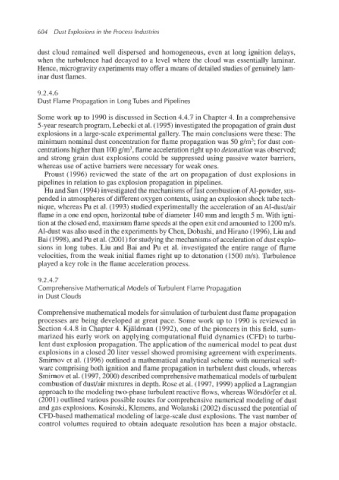Page 637 - Dust Explosions in the Process Industries
P. 637
604 Dust Explosions in the Process Industries
dust cloud remained well dispersed and homogeneous, even at long ignition delays,
when the turbulence had decayed to a level where the cloud was essentially laminar.
Hence, microgravity experimentsmay offer a means of detailed studies of genuinely lam-
inar dust flames.
9.2.4.6
Dust Flame Propagation in LongTubes and Pipelines
Some work up to 1990 is discussed in Section 4.4.7 in Chapter 4. In a comprehensive
5-year research program, Lebecki et al. (1995) investigated the propagation of grain dust
explosions in a large-scale experimental gallery. The main conclusions were these: The
minimum nominal dust concentration for flame propagation was 50 g/m3;for dust con-
centrations higher than 100g/m3,flame acceleration right up to detonation was observed;
and strong grain dust explosions could be suppressed using passive water barriers,
whereas use of active barriers were necessary for weak ones.
Proust (1996) reviewed the state of the art on propagation of dust explosions in
pipelines in relation to gas explosion propagation in pipelines.
Hu and Sun (1994) investigated the mechanisms of fast combustion of Al-powder, sus-
pended in atmospheres of different oxygen contents,using an explosion shock tube tech-
nique, whereas Pu et al. (1993) studied experimentally the acceleration of an AI-dustlair
flame in a one end open, horizontal tube of diameter 140mm and length 5 m. With igni-
tion at the closed end, maximum flame speeds at the open exit end amounted to 1200ds.
Al-dust was also used in the experimentsby Chen, Dobashi, and Hirano (1996),Liu and
Bai (1998), and Puet al. (2001) for studyingthe mechanismsof accelerationof dust explo-
sions in long tubes. Liu and Bai and Pu et al. investigated the entire range of flame
velocities, from the weak initial flames right up to detonation (1500 m/s). Turbulence
played a key role in the flame acceleration process.
9.2.4.7
Comprehensive Mathematical Models of Turbulent Flame Propagation
in Dust Clouds
Comprehensivemathematicalmodels for simulation of turbulent dust flame propagation
processes are being developed at great pace. Some work up to 1990 is reviewed in
Section 4.4.8 in Chapter 4. Kjaldman (1992), one of the pioneers in this field, sum-
marized his early work on applying computational fluid dynamics (CFD) to turbu-
lent dust explosion propagation. The application of the numerical model to peat dust
explosions in a closed 20 liter vessel showed promising agreement with experiments.
Smirnov et al. (1996) outlined a mathematical analytical scheme with numerical soft-
ware comprising both ignition and flame propagation in turbulent dust clouds, whereas
Smirnovet al. (1997,2000) described comprehensivemathematicalmodels of turbulent
combustion of dust/air mixtures in depth. Rose et al. (1997,1999) applied a Lagrangian
approach to the modeling two-phase turbulent reactive flows, whereas Worsdorfer et al.
(2001) outlined various possible routes for comprehensivenumerical modeling of dust
and gas explosions. Kosinski, Klemens, and Wolanski (2002) discussed the potential of
CFD-based mathematical modeling of large-scale dust explosions. The vast number of
control volumes required to obtain adequate resolution has been a major obstacle.

